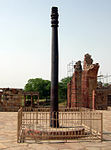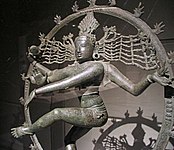
Back Historia de la metalurgia en el subcontinente indio Spanish Histoire de la métallurgie dans le sous-continent indien French भारतीय धातुकर्म का इतिहास Hindi Metallurgins historia på Indiska halvön Swedish
| |||||
 |
| History of science and technology in the Indian subcontinent |
|---|
| By subject |
The history of metallurgy in the Indian subcontinent began prior to the 3rd millennium BCE.[1] Metals and related concepts were mentioned in various early Vedic age texts. The Rigveda already uses the Sanskrit term ayas (Sanskrit: अयस्, romanized: áyas, lit. 'metal; copper; iron').[2] The Indian cultural and commercial contacts with the Near East and the Greco-Roman world enabled an exchange of metallurgic sciences.[3] The advent of the Mughals (established: April 21, 1526—ended: September 21, 1857) further improved the established tradition of metallurgy and metal working in India.[4] During the period of British rule in India (first by the East India Company and then by the Crown), the metalworking industry in India stagnated due to various colonial policies, though efforts by industrialists led to the industry's revival during the 19th century.
- ^ See Tewari (2003) and Arnold, 100-101.
- ^ wisdomlib.org (2017-12-20). "Ayas, Ayās, Āyas, Ayash: 15 definitions". wisdomlib.org. Retrieved 2023-10-22.
- ^ For Near East see Edgerton, 56 and Prasad, chapter IX. Greco-Roman world: Mondal, 2-3.
- ^ Gommans (2002)



